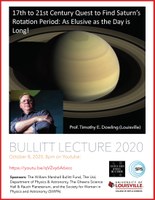Bullitt Lecture in Astronomy 2020 - 17th to 21st Century Quest to Find Saturn’s Rotation Period: As Elusive as the Day is Long!
| When |
Oct 08, 2020
from 08:00 PM to 09:00 PM |
|---|---|
| Where | YouTube - https://youtu.be/qVZvy6A6xcc |
| Contact Name | Benne Holwerda, Ph.D. |
| Contact Phone | (502)-852-0918 |
| Add event to calendar |
|
 The Physics & Astronomy Department’s Bullitt Lecture is a free lecture aimed at the general public. Since 2001, the Physics & Astronomy Department’s Bullitt Lecture has presented a distinguished astrophysicist to a Louisville audience in the Gheens Science Hall and Rauch Planetarium. Gale Christianson, Hubble's biographer at Indiana State, Fred Espenak, an eclipse expert at NASA Goddard Space Flight Center, stellar astrophysicists James Kaler of U. Illinois, C. R. O'Dell of Vanderbilt and Caty Pilachowski of Indiana U, cosmologists Fang Li Zhi of Arizona, J. Richard Gott of Princeton, Alan Dressler of the Carnegie Observatories and lunar experts Ferenc Pavlics of GM and the Apollo project and Phillip Abel of NASA have been Bullitt Lecturers. College and high school students, teachers, and many others from the community interested in the impact and excitement that astrophysics has generated have attended Bullitt Lectures in large numbers. The public and members of the University community are warmly invited!
The Physics & Astronomy Department’s Bullitt Lecture is a free lecture aimed at the general public. Since 2001, the Physics & Astronomy Department’s Bullitt Lecture has presented a distinguished astrophysicist to a Louisville audience in the Gheens Science Hall and Rauch Planetarium. Gale Christianson, Hubble's biographer at Indiana State, Fred Espenak, an eclipse expert at NASA Goddard Space Flight Center, stellar astrophysicists James Kaler of U. Illinois, C. R. O'Dell of Vanderbilt and Caty Pilachowski of Indiana U, cosmologists Fang Li Zhi of Arizona, J. Richard Gott of Princeton, Alan Dressler of the Carnegie Observatories and lunar experts Ferenc Pavlics of GM and the Apollo project and Phillip Abel of NASA have been Bullitt Lecturers. College and high school students, teachers, and many others from the community interested in the impact and excitement that astrophysics has generated have attended Bullitt Lectures in large numbers. The public and members of the University community are warmly invited!
The Lecture is endowed through a grant from the family of William Marshall Bullitt, the Solicitor General of the United States under President William Howard Taft. Here is a brief biography and description of his connection to the University of Louisville.
We also thank the Society for Woman in Physics and Astronomy (SWIPA) for their support.
Speaker: Timothy E. Dowling
Abstract: The majestic ringed planet Saturn has been studied by telescope for centuries, and in the modern era by three flyby spacecraft (Pioneer 11 and Voyager 1 and 2) and one flagship orbiter (Cassini), and yet we are still trying to figure out the length of its day. William Herschel was the first to publish a rotation period for Saturn, in 1794 (the same year that Kentucky and Vermont got their stars, and stripes, on the U.S. flag). However, it turns out that like Jupiter, Saturn has a strong prograde equatorial jet, and this is what Herschel measured, rather than the more fundamental bulk rotation period.
The quest has now spanned four centuries. Saturn’s magnetic dipole tilt does not exceed 0.007 deg, which is not sufficient to establish its rotation period via spacecraft, and Voyager’s back-up radio measurement was shown by Cassini to drift and be different in the north and south, which means the current IAU official value is not the rotation period of Saturn. But, we may now have it: because independent measurements in the last decade of waves in the atmosphere and in the inner C-ring both yield 10 hours 34 minutes. The history of this quest, and why the rotation period is important to our understanding of Saturn's internal structure, will be discussed.
